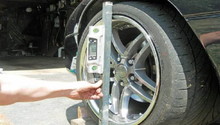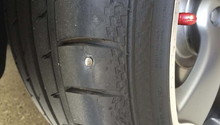Camaro and Firebird: How to Check Tire Tread
Learn how to keep tabs on tire tread depth and stay safe in all driving conditions.
This article applies to the Chevrolet Camaro and Pontiac Firebird (1996-present).
While tires are an extremely essential component to your driving experience and safety, the tire's tread depth is equally, if not more, important. Tire tread depth is the amount of tread remaining after continuous wear. It is only natural for the rubber on tires to wear down after continued use. Knowing how to check your tire tread depth can help you plan ahead and avoid dangerous situations. At some point, it is even becomes illegal to run a very low tread tire. You car will not be able to pass inspection if the tread depth is below 2/32 or 20%.
There are some general rules of thumb to follow: If you're planning on driving through wet roads, try to replace your tires when they read 4/32 or 40%. If driving in the snow is the norm, try to ensure you're replacing the tires when they reach 5/32 or 50% tread depth. Besides helping your car stop better on normal roads, a good amount of tread depth aids the vehicle in guiding water out of the grooves to avoid "hydroplaning" and getting a better grip in snowy or icy conditions.

Materials Needed
- Jack
- Jack stands (4)
- Wheel chocks
- Tread depth gauge
- 1 quarter
- 1 penny
Step 1 – Raise the vehicle
To get an accurate measure for where the tread depth lies on your tires, it will be helpful to get the car off the ground without having to remove the tires.
- Raise vehicle with the jack.
- Secure frame with jack stands.
- Chock rear wheels.

Pro Tip
Raise and secure the front of the vehicle, then use two more jack stands to secure the rear. This will allow you to inspect all four tires.
Step 2 – Check tread depth
Now that all four tires are exposed and accessible, we can check the tread depth.
- Using a tire tread depth gauge, insert the tool within the outer grooves on the first tire.
- Record your measurements.
- Move your way inward to cover the area across the tire width.
- Record your measurements.
- Repeat the steps for each tire.
- Compare your findings.

Pro Tip
You can use a penny or a quarter to perform the same tests. If the President's head is slightly covered through each tread groove, the tread is in good shape.
Step 3 – Assess any wear issues
Now that you have measured the tread depth across all four tires, you will want to address issues accordingly, if any.
- If one or more tires have yielded uneven wear, there may be an alignment problem.
- If one or more tires have yielded less than ideal tread depth, replace the tire(s) as soon as possible.

Pro Tip
There are many factors at play if all tires show slightly different signs. It may be wise to take the vehicle to an alignment shop to take a closer look at all components.
Related Sites
- Jack points - Camaro5.com
- Tech Page, Re: Tire tread depth - Tirerack.com
- CamaroZone: Estimating Tread Depth - Camarozone.com
- Chevrolet: Tire Wear article - Chevrolet.com






